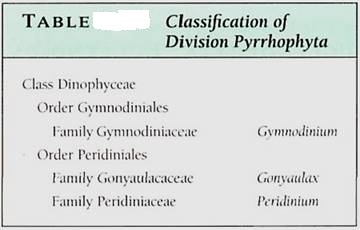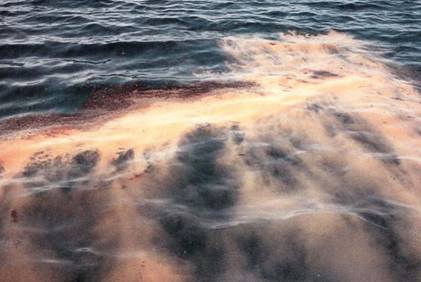


 النبات
النبات
 الحيوان
الحيوان
 الأحياء المجهرية
الأحياء المجهرية
 علم الأمراض
علم الأمراض
 التقانة الإحيائية
التقانة الإحيائية
 التقنية الحيوية المكروبية
التقنية الحيوية المكروبية
 التقنية الحياتية النانوية
التقنية الحياتية النانوية
 علم الأجنة
علم الأجنة
 الأحياء الجزيئي
الأحياء الجزيئي
 علم وظائف الأعضاء
علم وظائف الأعضاء
 الغدد
الغدد
 المضادات الحيوية
المضادات الحيوية|
Read More
Date: 17-11-2016
Date: 20-11-2016
Date: 17-11-2016
|
Division Pyrrhophyta: Dinoflagellates
Dinoflagellates ( Table) show many unusual characters that probably represent a relictual state: The nuclear envelope and nucleolus persist throughout mitosis, and a typical spindle does not form. Instead, channels open in the nucleus and large bundles of microtubules pass through. The chromosomes, which do not have centromeres and arc permanently condensed, are attached to the nuclear envelope, whose expansion during the formation of the nuclear channels causes the chromosomes to split. There are no histones.
Dinoflagellates arc almost exclusively motile and unicellular; only a few species such as Gonyaulax monilata form chains of similar cells with no differentiation. Flagella have a strikingly characteristic arrangement in dinoflagellates: One long flagellum lies in a longitudinal groove with its distal end free and responsible for swimming (Fig. 1). The other flagellum is flat and ribbon-like and lies completely within a transverse groove that encircles the cell. Most species are photosynthetic, but many are completely heterotrophic. Although some dinoflagellate characteristics are similar to those of the euglenoids, others are different: They have chlorophylls a and c, not a and b and their carotenoids are quite unusual. In addition to beta carotene, they also have several unique xanthophylls such as peridinin and dinoxanthin. Their reserve material is starch or oil. Dinoflagellates may lack a wall or have one consisting of cellulose plates whose arrangement and number are useful for identifying the genera and species.


FIGURE 1:Dinoflagellates have two flagella, one of which lies in a groove that encircles the cell (X 10,000). ('DavidPhillips/Photo Researchers).
Dinoflagellates have evolved to the level of having sexual reproduction. Vegetative cells releass small, naked cells that act as gametes; at the initiation of fusion, they become quiescent but then resume swimming, and the zygote may remain motile for 12 to 13 days. It then becomes thick walled and quiescent for about 2 months. During germination, it undergoes meiosis and a single haploid vegetative cell emerges—a new individual that glows and multiplies by mitosis.
Organisms with many relictual characters are often regarded as poorly adapted, perhaps surviving only in certain specialized, protected environments. But dinoflagellates are abundant throughout the oceans. Under conditions of ideal temperature and nutrients, population growth of some dinoflagellates, especially Gonyaulax and Gymnodinium, is explosive. Within a few days they become so numerous that their bodies actually color the water reddish brown—a "red tide" (Fig. 2). The density of dinoflagellates can be as high as 30,000 cells per milliliter of sea water. Red tides are becoming increasingly frequent in the Gulf of Mexico, a phenomenon that is unexplained at present. This fascinating biological spectacle is also dangerous, because these algae produce toxins, and their large concentrations kill fish and make other marine life poisonous to humans. The poisons of nay species, Gonyaulax catenella for instance, are potent neurotoxins, interfering with the movement of sodium ions across our nerve membranes.

FIGURE 2:The population density of dinoflagellates can rise so high that they color the water, producing a red tide. A few centimeters away, the density is so low that the water appears normal. (Carlton Ray/Photo Researchers)



|
|
|
|
التوتر والسرطان.. علماء يحذرون من "صلة خطيرة"
|
|
|
|
|
|
|
مرآة السيارة: مدى دقة عكسها للصورة الصحيحة
|
|
|
|
|
|
|
نحو شراكة وطنية متكاملة.. الأمين العام للعتبة الحسينية يبحث مع وكيل وزارة الخارجية آفاق التعاون المؤسسي
|
|
|